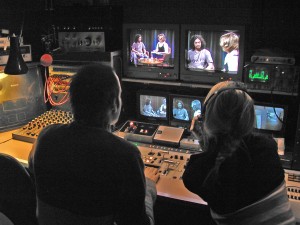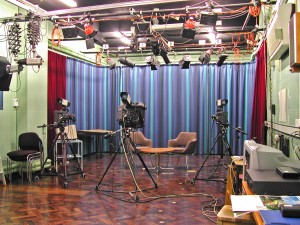If you were studying Chemistry at Imperial College in the early 1980’s you would almost certainly have come across the series of teaching videos that we made. These were designed to provide a single definitive version of classic experiments carried out in the labs. The way that it worked was that during a lab period students would have a number of ‘demonstrators’ who positioned themselves around the lab. They would then proceed to show the undergrads the way to achieve what was needed of them during the session. This was deemed to have flaws when it was discovered that very slightly different versions were actually being demonstrated. So, colleagues in the Chemistry Department asked for some of the experiments and also the techniques required, to be captured on video. These videos would then be made available to the students in the college library, prior to the lab session day and also at the start of the actual lab session via video players located around the lab. Starting 32 years ago, from 1981 to 1993, 11 of these classic experiment videos were made. Two of these: ‘Recrystallisation’ and ‘Using an Oil Vacuum Pump’ are seen on this page, and are for archive interest only.
Making them was not always so easy. To capture the experiments we needed to be able to record, as much as possible, in ‘real time’. That is, record the action without stopping or having to then edit later. We needed to be able to try and capture what would have been demonstrated live in the lab. Also, when an experiment had started, it couldn’t always be stopped on a whim from me because I couldn’t get a good camera view! So, we had to be able to record with several cameras and this meant shooting in the College TV Studio** where we had three cameras available. Shooting this way meant we could, as much as possible, run in real time; if we had rehearsed what was going to happen. So, using three cameras we were able to plan ‘blocks’ of the experiments that could be recorded before we had to stop and reset cameras etc
Chemistry in a TV Studio has its problems though. And one of THE biggest problems was with white lab coats. Our early colour cameras had a single stripe vidicon tube in them and the bright white labs coats were susceptible to almost glowing in the end result shot . The light required for good pictures was a little higher than for black & white and highlights would very easily burn out, a good example being the glassware. The three cameras also had manual adjustment for colour, so getting all three to give well balanced images, all the looking same, was a nightmare at times! Another problem was ensuring that I could see on the monitors what was required, without a hand or shoulder blocking the view. We tended to position a monitor so that the person demonstrating could see whether or not this was happening. It was easier for them to move than for the cameras to do so.
After 32 years some of the videos are starting to show their age and playback is becoming difficult. It took a few hours before I could get a stable playback I was happy with, in order to transfer them onto DVD.
If you studied Chemistry and came across these teaching videos during your course then please do let us know via the comment option below.
** Even though we are now in a “YouTube video age”, sadly in February 2007 Imperial closed the TV Studio, along with its Control Room, Editing Suite and also the Video Conferencing Service. However, the videotape archive remains; but is now held in the main college archive facilities, which I still have access to when required.
Colin Grimshaw May 2013


Wow – blast from the past 🙂
Henry showing us how to use the old trolley pumps – smashing !
I remember Dr. GBY doing a number of these too ?
Most of the videos were made by Henry Rzepa, but also Dr’s: Widdowson; Pratt; Woollins; Young and Smith I have listed as making videos too.
I hope these brought back a few memories?
My tutorial today was considerably enlivened by my learning (from my tutees) that this blast from the past was on YouTube. Fame at last!
I feel impelled to point out that the passage of 31 years has brought even greater consideration for safety. Thus nowadays one would probably also wear protective safety gloves! I also point out that our modern version of this video is purely schematic (as a Flash animation). I prefer the old style.
Yes indeed Henry, today we have health and safely at every stage of our lives! Chemistry was THE most forward thinking in using video for teaching and it’s sad that other departments never caught the bug to do the same. With the web, videos like these, could be used almost everywhere.
Making these videos was fun and did pose some challenges as I explained. but considering the time span, I think we did rather well. Glad they bring back memories of an “earlier Imperial time, now long gone”.
Great video on recrystallization. Even useful now to show non-chemistry majors the art of recrystallization. We at present are encoutering same problems shown in the video and found it very helpful.
Thank you
Peter Samuel
USA
Peter,
Glad you actually found this 30+ year old video of use! When I get the time I’ll be digitizing all of the remaining Chemistry videos and putting them onto the Imperial College YouTube channel.
I would add that the passage of 30+ years has changed some aspects. For example, most of the recrystallisation technique would nowadays be done in a fume cupboard. It was not possible to build such a cupboard in the TV studio! The apparatus has also changed. Heating mantles have evolved, and melting point apparatus is now digital. But recrystallisation is still very commonly done!
Current Imperial Chemistry student here (in 2nd year) – 40 years later!
I will be sending these to Dr. Laura Patel, who nowadays runs the teaching labs in years 1 and 2 – we do indeed recrystallize, but in the fume hoods!